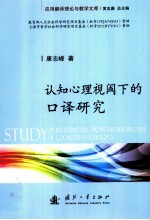图书介绍
认知心理视阈下的口译研究PDF|Epub|txt|kindle电子书版本网盘下载

- 康志峰著 著
- 出版社: 北京:国防工业出版社
- ISBN:9787118083354
- 出版时间:2012
- 标注页数:290页
- 文件大小:7MB
- 文件页数:188页
- 主题词:英语-口译-研究
PDF下载
下载说明
认知心理视阈下的口译研究PDF格式电子书版下载
下载的文件为RAR压缩包。需要使用解压软件进行解压得到PDF格式图书。建议使用BT下载工具Free Download Manager进行下载,简称FDM(免费,没有广告,支持多平台)。本站资源全部打包为BT种子。所以需要使用专业的BT下载软件进行下载。如BitComet qBittorrent uTorrent等BT下载工具。迅雷目前由于本站不是热门资源。不推荐使用!后期资源热门了。安装了迅雷也可以迅雷进行下载!
(文件页数 要大于 标注页数,上中下等多册电子书除外)
注意:本站所有压缩包均有解压码: 点击下载压缩包解压工具
图书目录
Chapter One Introduction1
1.1 Statement of the Problem6
1.2 Context of the Study10
1.2.1 Interpretation Studies in the West10
1.2.2 Interpretation Studies in China12
1.2.3 The Development of Cognitive Psychology17
1.3 Methodology and Rationale of the Study18
1.4 The Main Issues to Be Researched20
1.5 Significance and Feasibility of the Study22
1.5.1 The Theoretical Significance of the Study22
1.5.2 The Realistic Significance of the Study23
1.5.3 Feasibility of the Study24
1.6 Dissertation Chapter Organization26
Chapter Two Literature Review29
2.1 General Anxiety Research29
2.1.1 The Classification of General Anxiety30
2.1.2 Distinctions of General Anxiety30
2.1.3 Effects of General Anxiety Theory on This Study32
2.2 Interpretation Memory Research34
2.2.1 Memory Processing Research34
2.2.2 Memory Mechanism in Interpretation40
2.2.3 Summary42
2.3 AP Research42
2.3.1 Auditory Physiology Research42
2.3.2 Auditory Attention Research44
2.3.3 Listening and Interpreting Research47
2.3.4 The Design of AA Mode55
2.4 IA Research56
2.4.1 Difficulty of SL56
2.4.2 Syntactic Differences between SL and TL57
2.4.3 The Relevance of Cognitive Psychology to Interpreting58
2.4.4 Anxiety and Interpreting Aptitude61
2.4.5 Enlightenment of the Newest Studies63
2.4.6 Summary65
2.4.7 The Design of IA Mode66
Chapter Three Theoretical Exploration of AA Mode68
3.1 Initiative AA Mode Research68
3.2 The Purpose of AA Mode Study69
3.3 Definition of AA Mode69
3.4 The Sources,the Scope and the Severity of AA70
3.4.1 The Sources of AA70
3.4.2 The Scope of AA mode75
3.4.3 The Severity of AA76
3.5 The Impacts of AA on Interpretation76
3.5.1 AA Impacts on Input78
3.5.2 AA Impacts on IP81
3.5.3 AA Impacts on Interpreting Output85
3.6 Summary88
Chapter Four Theoretical Exploration of IA Mode90
4.1 The Purpose of IA Mode Study90
4.2 Definition of IA Mode and Relationship between IA Mode and Interpreting91
4.3 The Sources of IA91
4.3.1 Illocutionary Stressors of IA92
4.3.2 Locutionary Stressors of IA98
4.4 The Psychological Analyses of IA Mode101
4.4.1 Fear of Public Interpreting102
4.4.2 Standing in Evaluation of Others102
4.4.3 Lack of Self-Confidence and Insecurity103
4.4.4 Feelings of Threat104
4.5 The Manifestations of IA105
4.6 Scale of Students'IA106
4.6.1 Scale of Traditional Interpreting Anxiety106
4.6.2 Theoretical Bases of IAS108
4.6.3 Scope of Students'IA110
4.7 Severity of Students'IA110
4.7.1 Severity of HA111
4.7.2 Severity of LA112
4.8 IA Impacts on Interpreting113
4.8.1 HA Impacts113
4.8.2 LA Impacts113
4.8.3 Effects of MA115
4.8.4 IA Impacts on Deixis116
4.8.5 IA Impacts on Memory of Interpreting117
4.8.6 IA Impacts on Expressivity119
Chapter Five Empirical Studies of AA Mode120
5.1 The Survey of Empirical Studies120
5.2 The Initiation of AA Mode Empirical Studies123
5.3 The Purpose of AA Mode Empirical Studies and Questions Revisited124
5.4 Empirical Studies on the Sources,the Scope and the Severity of AA125
5.4.1 Evidences for the Sources of AA125
5.4.2 Evidences for the Scope of AA Mode140
5.4.3 Evidences for the Severity of AA158
5.5 Evidences for the Impacts of AA on Interpretation161
5.5.1 Evidences for AA Impacts on Input of Interpretation161
5.5.2 Evidences for AA Impacts on IP of Interpretation163
5.5.3 Evidences for AA Impacts on Output of Interpretation165
5.6 Coping Strategies170
5.6.1 “A?+E?”Strategy170
5.6.2 Medium Arousal Strategy171
5.6.3 RL-Mode Strategy174
5.6.4 Five Classroom Strategies175
5.7 Summary182
Chapter Six Empirical Studies of IA Mode184
6.1 The Purpose of IA Empirical Studies184
6.2 Methodologies of IA Empirical Studies185
6.3 Empirical Studies on Question One186
6.3.1 Evidences for Sources of IA186
6.3.2 Evidences for the Scale of IA192
6.3.3 Evidences for the Severity of IA201
6.3.4 Evidences for IA Impacts on Interpreting205
6.4 Empirical Studies on Question Two212
6.4.1 Preparation of the Survey Research212
6.4.2 The Survey of Students212
6.4.3 Comparative Studies of the Surveys216
6.5 Empirical Studies on Question Three220
6.5.1 Definition of"A?+E?"Strategy221
6.5.2 Deconstruction of"A?+E?"Strategy221
6.5.3 A? Strategy in the Domain of AS223
6.5.4 Medium Arousal Strategy225
6.5.5 EM and"E?"Strategy226
6.5.6 Individual Mood Adjustment Strategy229
6.6 Summary231
Chapter Seven Correlations between AA Mode and IA Mode233
7.1 Differences between AA Mode and IA Mode233
7.2 Similarities between AA Mode and IA Mode234
7.3 The Correlation between AAS and IAS235
7.4 The HA Correlation between AA Mode and IA Mode239
7.5 The Result Correlation between AA Mode and IA Mode241
7.6 The Prominence of AA242
7.7 Summary243
Chapter Eight Concluding Remarks245
8.1 Achievements of This Study245
8.1.1 Theoretical Construction of AA and IA245
8.1.2 AA and IA Findings through Empirical Studies248
8.1.3 AA and IA Strategy Use253
8.2 Implications of This Study254
8.2.1 Theoretical Implications254
8.2.2 Instructional Implications255
8.3 Limitations of the Study256
8.4 Suggestions for Future Studies258
8.5 Conclusion259
Appendix A CTAS261
Appendix B Questionnaire Ⅰ263
Appendix C Questionnaire Ⅱ265
Appendix D Questionnaire Ⅲ266
Appendix E Questionnaire Ⅳ268
Appendix F Questionnaire Ⅴ269
Appendix G Questionnaire Ⅵ270
Appendix H Questionnaire Ⅶ272
References275